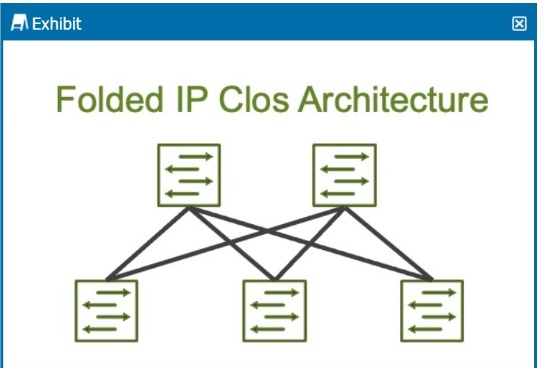Most Recent Juniper JN0-280 Exam Dumps
Prepare for the Juniper Data Center, Associate Exam exam with our extensive collection of questions and answers. These practice Q&A are updated according to the latest syllabus, providing you with the tools needed to review and test your knowledge.
QA4Exam focus on the latest syllabus and exam objectives, our practice Q&A are designed to help you identify key topics and solidify your understanding. By focusing on the core curriculum, These Questions & Answers helps you cover all the essential topics, ensuring you're well-prepared for every section of the exam. Each question comes with a detailed explanation, offering valuable insights and helping you to learn from your mistakes. Whether you're looking to assess your progress or dive deeper into complex topics, our updated Q&A will provide the support you need to confidently approach the Juniper JN0-280 exam and achieve success.
The questions for JN0-280 were last updated on May 2, 2025.
- Viewing page 1 out of 13 pages.
- Viewing questions 1-5 out of 65 questions
In the Junos OS, which feature is used to create an alternate next hop with a unique preference for a static route?
In Junos OS, the qualified-next-hop feature is used to specify an alternate next hop for a static route, along with a unique preference value.
Step-by-Step Breakdown:
Qualified-Next-Hop:
A qualified-next-hop allows you to define multiple next hops for a static route, each with its own preference. This provides flexibility by allowing the router to choose the best available next hop based on reachability and preference.
Use Case:
If the primary next hop becomes unreachable, the router can automatically switch to the alternate next hop defined by the qualified-next-hop with a higher preference value.
Command Example:
set routing-options static route 10.10.10.0/24 qualified-next-hop 192.168.1.1 preference 5
set routing-options static route 10.10.10.0/24 qualified-next-hop 192.168.1.2 preference 10
Preference:
The next hop with the lowest preference is chosen first. If it becomes unavailable, the router will use the higher preference next hop.
Juniper Reference:
Qualified-Next-Hop: This feature is used to configure backup or alternate next hops for static routes in Juniper devices.
Which state in the adjacency process do OSPF routers check the MTU size?
In OSPF, routers exchange link-state information in different stages to establish full adjacency. The MTU size is checked during the Exchange state.
Step-by-Step Breakdown:
OSPF Adjacency Process:
OSPF routers go through multiple stages when forming an adjacency: Down, Init, 2-Way, ExStart, Exchange, Loading, and Full.
Exchange State:
During the Exchange state, OSPF routers exchange Database Description (DBD) packets to describe their link-state databases. The MTU size is checked at this stage to ensure both routers can successfully exchange these packets without fragmentation.
If there is an MTU mismatch, the routers may fail to proceed past the Exchange state.
Juniper Reference:
MTU Checking in OSPF: Junos uses the Exchange state to check for MTU mismatches, ensuring that routers can properly exchange database information without packet fragmentation issues.
Which two statements are correct about EVPN-VXLAN overlay networking? (Choose two.)
EVPN-VXLAN is an overlay technology used in data center networks to extend Layer 2 services over a Layer 3 network.
Step-by-Step Breakdown:
BGP Control Plane:
BGP (Border Gateway Protocol) is used as the control plane for EVPN-VXLAN. BGP advertises MAC addresses and IP address reachability information across the VXLAN network, enabling efficient multi-tenant Layer 2 connectivity over a Layer 3 infrastructure.
Encapsulation:
VXLAN (Virtual Extensible LAN) encapsulates Layer 2 frames into Layer 3 packets. This encapsulation allows Layer 2 traffic to be transported across a Layer 3 network, effectively creating a tunnel for Ethernet frames.
Juniper Reference:
EVPN-VXLAN Configuration: Juniper supports EVPN-VXLAN with BGP as the control plane, allowing scalable Layer 2 connectivity over a routed infrastructure in modern data centers.
A routing policy has been created to advertise OSPF routes in BGP. Which statement is correct in this scenario?
When advertising OSPF routes into BGP, the appropriate routing policy should be applied as an export policy in BGP.
Step-by-Step Breakdown:
OSPF to BGP Route Advertisement:
Routes learned via OSPF (a dynamic IGP) need to be exported into BGP to be advertised to external BGP peers. In Junos OS, this is done using export policies.
Export Policies in BGP:
An export policy controls which routes are advertised out of a BGP session. In this scenario, the routing policy must be applied to BGP as an export policy to export the OSPF-learned routes to external BGP peers.
Policy Configuration:
Example configuration:
set policy-options policy-statement EXPORT_OSPF term 1 from protocol ospf
set policy-options policy-statement EXPORT_OSPF term 1 then accept
set protocols bgp group <group-name> export EXPORT_OSPF
This policy ensures that only OSPF routes are exported into BGP.
Juniper Reference:
Routing Policy: Export policies are used in BGP to control route advertisements to peers, including those learned via OSPF.
Exhibit:

How many stages are shown in the exhibit?
The exhibit shows a Folded IP Clos Architecture, which is also referred to as a 3-stage Clos network design. This architecture typically consists of two layers of switches:
Spine Layer: The top row of switches.
Leaf Layer: The bottom row of switches.
Step-by-Step Breakdown:
Clos Architecture:
A 3-stage Clos network has two types of devices: spine and leaf. In this design, each leaf switch connects to every spine switch, providing a high level of redundancy and load balancing.
Stage Explanation:
Stage 1: The first set of leaf switches.
Stage 2: The spine switches.
Stage 3: The second set of leaf switches.
The Folded Clos architecture shown here effectively 'folds' the 3-stage design by combining the ingress and egress leaf layers into one, reducing it to two visible layers, but still maintaining the overall 3-stage architecture.
Juniper Reference:
IP Clos Architecture: The 3-stage Clos design is commonly used in modern data centers for high availability, redundancy, and scalability.
Unlock All Questions for Juniper JN0-280 Exam
Full Exam Access, Actual Exam Questions, Validated Answers, Anytime Anywhere, No Download Limits, No Practice Limits
Get All 65 Questions & Answers